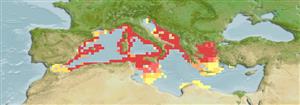Elasmobranchii (sharks and rays) >
Rajiformes (Skates and rays) >
Rajidae (Skates)
Etymology: Raja: Latin, raja, -ae = a sting ray (Raja sp.) (Ref. 45335).
Environment / Climate / Range
Ecology
Marine; demersal; depth range 100 - 400 m (Ref. 3167). Subtropical, preferred ?
Northeast Atlantic: known only from the western Mediterranean, more common along the African coasts.
Size / Weight / Age
Maturity: Lm ? range ? - ? cm
Max length : 60.0 cm TL male/unsexed; (Ref. 3167)
Found mainly on soft bottoms (Ref. 3167). Feed mainly on crustaceans and bony fishes depending on the sex, size and also partly with the season (Ref. 3167). Oviparous. Distinct pairing with embrace. Young may tend to follow large objects, such as their mother (Ref. 205). Eggs are oblong capsules with stiff pointed horns at the corners deposited in sandy or muddy flats (Ref. 205). About 20-62 eggs are laid by an individual in a year (Ref. 41314).
Oviparous, paired eggs are laid. Embryos feed solely on yolk (Ref. 50449). Ripe females occurring mostly in the winter and deposit 20 to 62 egg-cases per year depending on size (Ref. 3167). Distinct pairing with embrace. Y oung may tend to follow large objects, such as their mother (Ref. 205).
McEachran, J.D. and K.A. Dunn, 1998. Phylogenetic analysis of skates, a morphologically conservative clade of elasmobranchs (Chondrichthyes: Rajidae). Copeia 1998(2):271-290. (Ref. 27314)
IUCN Red List Status (Ref. 115185)
CITES (Ref. 94142)
Not Evaluated
Threat to humans
Harmless
Human uses
More information
ReferencesAquacultureAquaculture profileStrainsGeneticsAllele frequenciesHeritabilityDiseasesProcessingMass conversion
Tools
Special reports
Download XML
Internet sources
Estimates of some properties based on models
Phylogenetic diversity index (Ref.
82805): PD
50 = 0.5000 [Uniqueness, from 0.5 = low to 2.0 = high].
Bayesian length-weight: a=0.00166 (0.00087 - 0.00318), b=3.28 (3.12 - 3.44), in cm Total Length, based on LWR estimates for this species & Genus-body shape (Ref.
93245).
Trophic Level (Ref.
69278): 4.0 ±0.65 se; Based on food items.
Resilience (Ref.
69278): Low, minimum population doubling time 4.5 - 14 years (Fec=20).
Vulnerability (Ref.
59153): Moderate vulnerability (44 of 100) .
